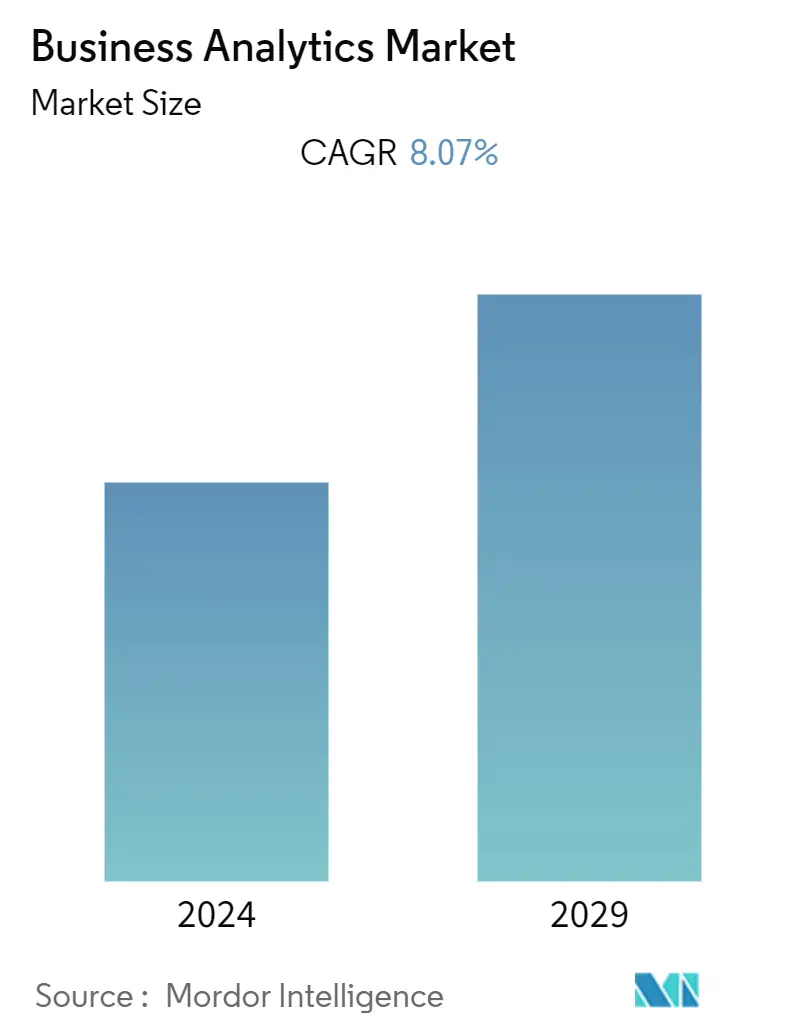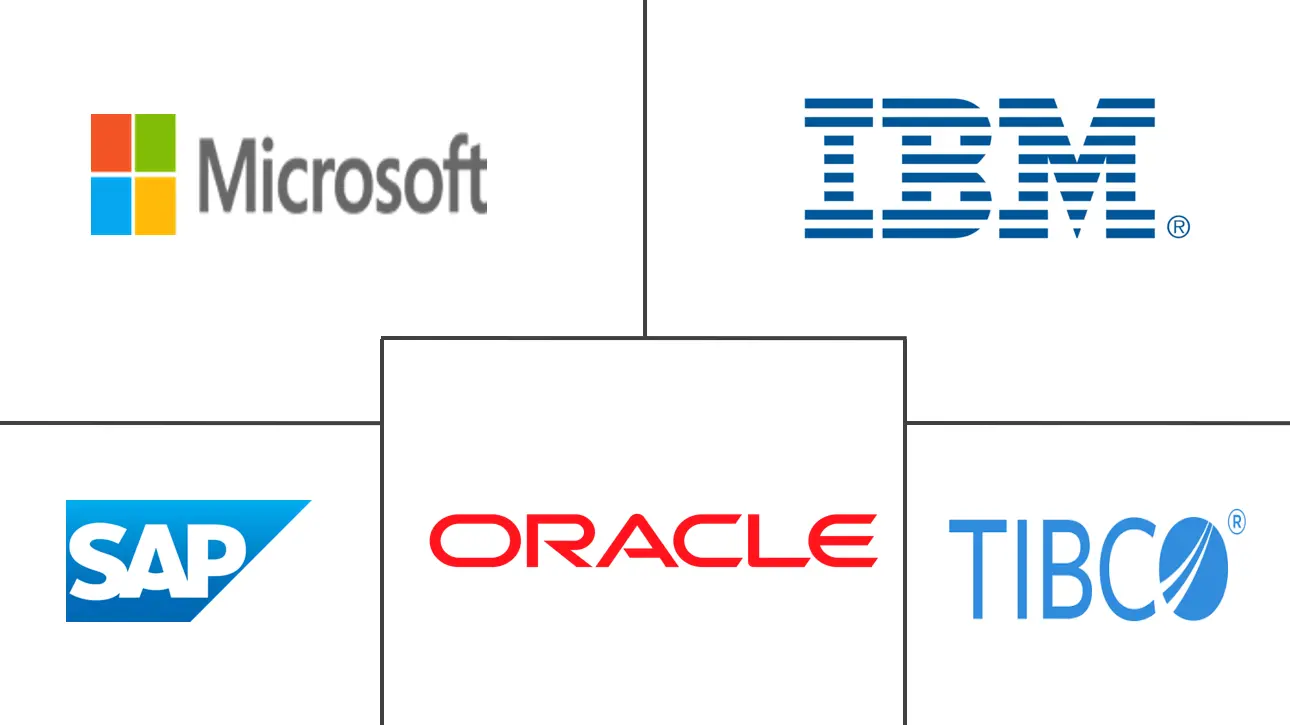Market Size of Business Analytics Industry

| Study Period | 2019 - 2029 |
| Base Year For Estimation | 2023 |
| CAGR (2024 - 2029) | 8.07 % |
| Fastest Growing Market | Asia Pacific |
| Largest Market | North America |
| Market Concentration | Low |
Major Players
*Disclaimer: Major Players sorted in no particular order |
Business Analytics Market Analysis
The Business Analytics Market is expected to register a CAGR of 8.07% during the forecast period.
- The business analytics market is primarily driven by the increasing digitalization across end-user industries and the need to improve their businesses with a better understanding of the customers. In addition, market vendors' integration of advanced technologies in business analytics solutions is expected to drive the market in the coming years.
- The business analytics market is evolving quickly. Increasingly, the emphasis is on real-time Business Intelligence (BI) to enable faster decision-making and on Data Visualization, which enables data patterns to be seen more clearly. Additionally, demand for more efficient business analytics solutions is anticipated to be driven by increasing usage among various end users in the upcoming years.
- Traditionally, strategic decisions in many organizations were powered by business analytics that relied on big, centralized-managed data servers or warehouses. However, things have changed recently, and business analysts are pulling data from dozens of heterogeneous data sources.
- In addition, visualization and explorative data analysis for the business user have been evolving into one of the most critical trends in the business analytics market. Various end-user industries also leverage business analytics' power to make strategic business decisions. While business analytics solution helps in supply chain management, inventory management, measuring the performance of targets, and risk mitigation plans in manufacturing, it is extended to include fraud detection and defense.
- Further, the vendors are introducing innovative business analytics solutions by integrating advanced technologies for better data storage facilities and visualization. For instance, modern Machine Language (ML) - powered business analytics platforms offer improved data visibility and comprehension. Furthermore, the proliferation of data has enabled startups to compete successfully with established blue-chip firms by building customized and superior analytics offerings.
- The COVID-19 pandemic led to a boom in digital transformation, such as adopting cloud solutions, Artificial Intelligence (AI), and ML across various industries. The outbreak accelerated many companies' use of advanced business analytics and AI. These strategies helped engage customers through digital channels, manage fragile and complex supply chains, and support workers by disrupting their work and lives. The demand for business analytics solutions exceeded pre-COVID-19 and is expected to grow in the coming years.
Business Analytics Industry Segmentation
Business analytics refers to the technologies, practices, and skills for continual step-by-step exploration and investigation of the past performance of the businesses to gain various insights and drive business strategy and planning accordingly. Companies use business analytics software for query reporting and analysis tools, advanced and predictive analytics, location intelligence, content analytics, data warehousing platforms, and enterprise performance management.
The business analytics market is segmented by Deployment (Cloud, On-premise, and Hybrid), End-user Industry (BFSI, Healthcare, Manufacturing, Retail, IT, and Telecom), and Geography (North America, Europe, Asia-Pacific, Latin America, and Middle East and Africa). The market sizes and forecasts are provided in terms of value in USD for all the above segments.
| By Deployment | |
| On-premise | |
| Cloud-based | |
| Hybrid |
| By End-user Industry | |
| Banking, Financial Services, and Insurance | |
| Healthcare | |
| Manufacturing | |
| Retail | |
| Telecom and IT | |
| Other End-user Industries |
| Geography | |
| North America | |
| Europe | |
| Asia-Pacific | |
| Latin America | |
| Middle East and Africa |
Business Analytics Market Size Summary
The business analytics solutions market is experiencing significant growth, driven by the increasing digitalization across various industries and the need for enhanced customer insights. The integration of advanced technologies such as artificial intelligence and machine learning into business analytics solutions is further propelling market expansion. The focus has shifted towards real-time business intelligence and data visualization, enabling faster decision-making and clearer data patterns. This evolution is supported by the growing demand for efficient analytics solutions across diverse end-user sectors, including manufacturing, finance, and retail. The COVID-19 pandemic has accelerated the adoption of digital transformation strategies, with businesses leveraging analytics to manage complex supply chains and engage customers through digital channels. This trend is expected to continue, with businesses increasingly relying on analytics to drive strategic decisions and gain a competitive edge.
In the banking and finance sector, the adoption of business analytics is transforming operations by optimizing processes and enhancing decision-making capabilities. Financial institutions are utilizing analytics tools to leverage customer data, improve profitability, and mitigate risks. The proliferation of digital payments and the need for robust risk management are further driving the demand for analytics solutions in this industry. Prominent market players like Microsoft, Oracle, and Salesforce.com are leading the charge with continuous product innovations, while emerging companies are also making significant strides by offering innovative solutions. The region's early adoption of advanced technologies and cloud computing is facilitating the implementation of customized analytics solutions, thereby increasing demand. The market is characterized by fragmentation, with numerous small and medium-sized enterprises competing alongside large corporations, and is witnessing partnerships and mergers that enhance competitive advantage.
Business Analytics Market Size - Table of Contents
-
1. MARKET DYNAMICS
-
1.1 Market Overview
-
1.2 Industry Attractiveness - Porter's Five Forces Analysis
-
1.2.1 Bargaining Power of Suppliers
-
1.2.2 Bargaining Power of Consumers
-
1.2.3 Threat of New Entrants
-
1.2.4 Threat of Substitute Products
-
1.2.5 Intensity of Competitive Rivalry
-
-
1.3 Industry Value Chain Analysis
-
1.4 Assessment of the Impact Of COVID-19 on the Industry
-
-
2. MARKET SEGMENTATION
-
2.1 By Deployment
-
2.1.1 On-premise
-
2.1.2 Cloud-based
-
2.1.3 Hybrid
-
-
2.2 By End-user Industry
-
2.2.1 Banking, Financial Services, and Insurance
-
2.2.2 Healthcare
-
2.2.3 Manufacturing
-
2.2.4 Retail
-
2.2.5 Telecom and IT
-
2.2.6 Other End-user Industries
-
-
2.3 Geography
-
2.3.1 North America
-
2.3.2 Europe
-
2.3.3 Asia-Pacific
-
2.3.4 Latin America
-
2.3.5 Middle East and Africa
-
-
Business Analytics Market Size FAQs
What is the current Business Analytics Market size?
The Business Analytics Market is projected to register a CAGR of 8.07% during the forecast period (2024-2029)
Who are the key players in Business Analytics Market?
Oracle Corporation, IBM Corporation, SAP SE, Microsoft Corporation and Tibco Software Inc. are the major companies operating in the Business Analytics Market.

